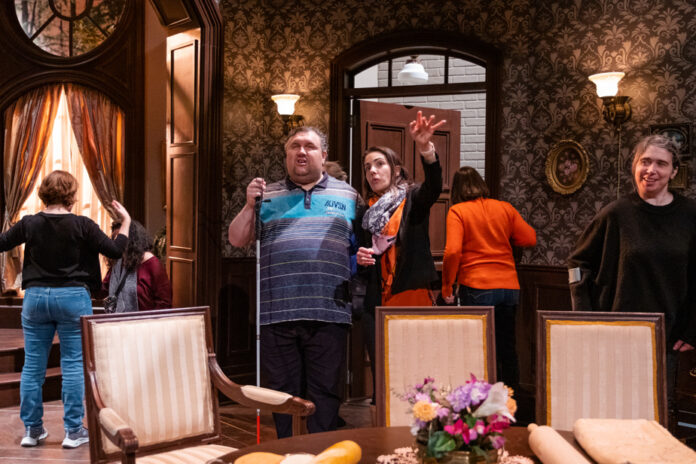Too often, theater doors are closed to people with hearing or visual limitations. The services offered to promote their access to live art are extremely rare. But the situation is changing.
Several initiatives are beginning to appear in Montreal institutions, in particular at the Théâtre du Rideau Vert, which has positioned itself as a leader in the universal accessibility file.
Since last September, the theater on rue Saint-Denis has been offering services adapted to the needs of people who are blind, deaf or hard of hearing: live theatrical description, translation into Quebec sign language (LSQ) and surtitling in coded French, a technology that opera lovers already know. For each of these specific services, one performance per piece presented is offered this season.
Erika Malot, artistic development coordinator and manager of the universal accessibility project at the Rideau Vert, explains: “Quebec was lagging behind in terms of cultural inclusion, particularly compared to the United States and Europe, in especially compared to the UK. In Montreal, the Anglophone environment is also ahead of ours. However, with the pandemic, we have witnessed the development of new technologies and we have become more aware of audiences who do not come to the theater. We realized that there were possible adaptations. »
Érika Malot has also set up a community of practice that brings together several theaters in Montreal and Quebec, support organizations and people who have to deal with limitations. “It’s a place of exchange to share our ideas, our solutions. There is something going on. The initiative is starting to take off. »
In the wake of this community of practice, the Center du Théâtre d’Aujourd’hui (CTd’A) has decided to offer, on April 18, a performance with surtitles in coded French of the play Les filles du Saint-Laurent . A performance with audio description of Clandestines was also presented in February.
Next year, this offer will increase, promises Marion Guillaume, communications and mediation coordinator at the CTd’A. “Four surtitled shows are on the program, as well as a performance with audio description. »
“We are at the very beginning of the project, but the more we do, the more it will be known, the more the offer will be recurrent, estimates Marion Guillaume. We would also like to build a calendar with the other theaters to offer a diversified offer that is spread throughout the season. »
The dance community is also beginning to turn to this clientele with special needs. Since October 2021, Danse-Cité, a Montreal company dedicated to the production and dissemination of dance and contemporary creation, has been offering an audio description service for choreographed works. Nine shows were described live, minute by minute. The 10th will be Encantado, by Brazilian choreographer Lia Rodrigues, presented as part of the Festival TransAmériques.
How can one describe dance works in words to blind people for whom words like arabesque mean nothing? “The writing of the audio description is adapted,” explains Maud Mazo-Rothenbühler, director of development and communications at Dance-Cité. “It’s an in-between between the spectator’s imagination and the particular aesthetic of each choreographer. »
“We have a loyal viewer base of about 50 people. During performances with audio description, we also offer human accompaniment, a guide for each blind person. The companion can attend the show for free and tickets for people with visual limitations are at a very preferential rate of $20. We know that many of them live in a very precarious situation. We want the offer to be adapted in all possible facets. »
And what about the middle of the circus? Danse-Cité hopes to extend its service to the circus arts next year.
Adding services like Quebec Sign Language (LSQ) translation comes at a price. And it is high, in particular because sign language interpreters have to work around thirty hours before the performance. Additionally, at the Rideau Vert, each LSQ performer carries the lines of one or two characters, as long as those two are not on stage at the same time. For the play The Son, they were five to sign the text of Florian Zeller.
“LSQ performers have to take ownership of their character, adapt their mannerisms, translate the emotions that are perceptible in the voice,” says Erika Malot. It’s their whole body that moves, from the top of the head to the waist. The face is very active. To properly translate the anger of one or the sadness of the other, the performers will rehearse with the actors to familiarize themselves with the style and rhythm of each.
All of this takes time and money. “Funding is really the sinews of war for the sustainability of all these projects,” says Maud Mazo-Rothenbühler. At Danse-Cité, funding is assured for next season. But you have to think about the future…”
Actor Paul Ahmarani starred in A Doll’s House, Part 2; he lived from the inside the performances in Quebec Sign Language (LSQ), in theatrical description and with surtitling. “That was awesome! Hug, how come we neglected a part of the population for so long? It is a duty of humanity, I think. It was an incredible experience, because for the first time in my theater career, I felt like I was understood by people who otherwise wouldn’t have been able to. It was very touching. LSQ interpreters are not disturbing for the actors, because they are springboards to carry our word. They are our extension. »















